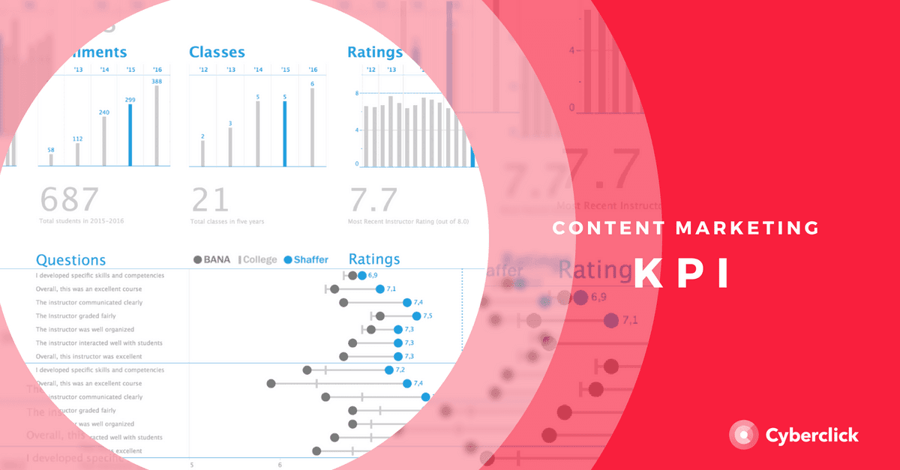By Laia Cardona, on 5 June 2018
So lets imagine you decide to go on a diet, and you sign up for the gym with the goal of losing weight. However, to know whether or not your attempts are proving successful, you decide to measure your height instead of getting on a scale and tracking your weight. You grow frustrated, because despite your best efforts, nothing seems to be changing. Ridiculous, is it not? Well, the same goes for many digital marketers when the time comes to align their KPIs with their content goals.
Key metrics and Content Objectives
Knowing how to measure your key metrics is essential to the success of your online marketing strategy. The views, likes and shared content are not a goal in themselves, but a way to indicate whether or not you are on the right path to achieving your goals. This is why I would like to explain today how to align your KPIs with your content objectives, according to your brand’s goals.
Goal no. 1: Generating Leads
According to a study by the Content Marketing Institute, generating leads is the main goal for 85% of marketers. To find out if your content is helping you acquire more and better leads, you need to align the following metrics:
- Click Through Rate. All of your articles should include a highlighted Call-To-Action. If you’re publishing as a guest on someone else’s platform, the call-to-action can be a click that redirects to your website or blog. If your content is going to be published on your own platform, it can be the download of an eBook by filling in a form. In any case, it should be a clear action with an attractive reward for the user. Measuring the CTR (Click Through Rate) will help you understand which combinations of content an action work best.
- Conversions. Acquiring leads is very important, but don’t forget that the final goal of getting a lead is to convert it. You will have to use your investigation and detective skills to find out which leads have the most chances of becoming clients. Discover as much as you can about them, from their age to their LinkedIn account, as well as the kind of tweets they post, and compare your data over time to see which ones are most likely to convert. Once you have identified a pattern, you can focus your efforts on the more interesting leads.
Goal no. 2: Increasing sales
In the end, most companies have the same common need: to sell their products! For this reason, no strategy is truly complete if it does not take this into account. To know if your content objectives are working, you need to compare different data, between the users that are consuming your product and those who aren’t:
- Conversion Rate. Your content should be helping you gain your potential clients’ trust by answering their doubt and objections. As a result, the conversion rate of your content’s followers should be bigger.
- The length of the sales cycle. If you’re doing it right, the sales cycle of the users who consume your content should be shorter than the average company’s.
- Average client value. If your content helps overcome or minimize your clients’ barriers and resistance, it should help you sell more to each one, and gain their loyalty over time. Compare the value of an average client who has been exposed to your content to that of those who haven’t to see if you’re on the right track.
Goal no. 3: Branding
Brand awareness continues to be a priority for 77% of marketers. Some don’t consider it a KPI, as measuring it directly is very complicated and requires very thorough market studies. But don’t let this get you down: increasing your brand’s impact is a great content objective, and aligning these metrics will give you a good hint as to your successfulness:
- Amount of people who see and share your content. Measure how many people view and share each of your pieces of content and follow its progress. Hubspot is an amazing tool to follow these metrics and see which types of content, formats, times of day, days of the week, etc. work best for you and your audience.
- Article visits. If you publish exclusively on your own platforms, it will be very easy for you to keep this metric under control. On the other hand, if you collaborate with external platforms, you will have to keep track of the number of visitors brought to your blog via links. Either way, the more people who are exposed to your content, the more people will know your brand. Don’t forget to take a look at the bounce rate and average time spent per session to get a real idea of your content’s impact.
Goal no. 4: Interact with your audience
Another fantastic way to measure the impact of your content and your brand’s “health” is through your audience’s interaction. To stay up to date with what’s going on, be sure to track these metrics:
- Shared content. Here, you should know how many times your content is shared on each social network, and also who it is being shared by. Getting your content to go viral is great, but numbers mean nothing if you are not getting to your target audience.
- Comments. Ignore all the spam and focus on the people who most comment on your content. What is it that they like or dislike, and how can you adapt your content to fit their needs? Remember that you can also contact them personally or through social networks to continue the conversation!
- Clicks. The comments and shares are good metrics to follow, but some users are a little shyer. So I would recommend to not stop measuring clicks, to know which contents are able to attract more users.
In conclusion
Greta part of your content strategy’s success depends on your ability to identify the correct metrics, to follow your progress and adjust your track in order to improve every day. If you don’t have a system to control your content objectives, you wont be able to know if you have achieved your goals, nor set aside the tactics that simply aren’t working as planned.
So, if you want to create better and better content each day, start measuring your KPIs!



